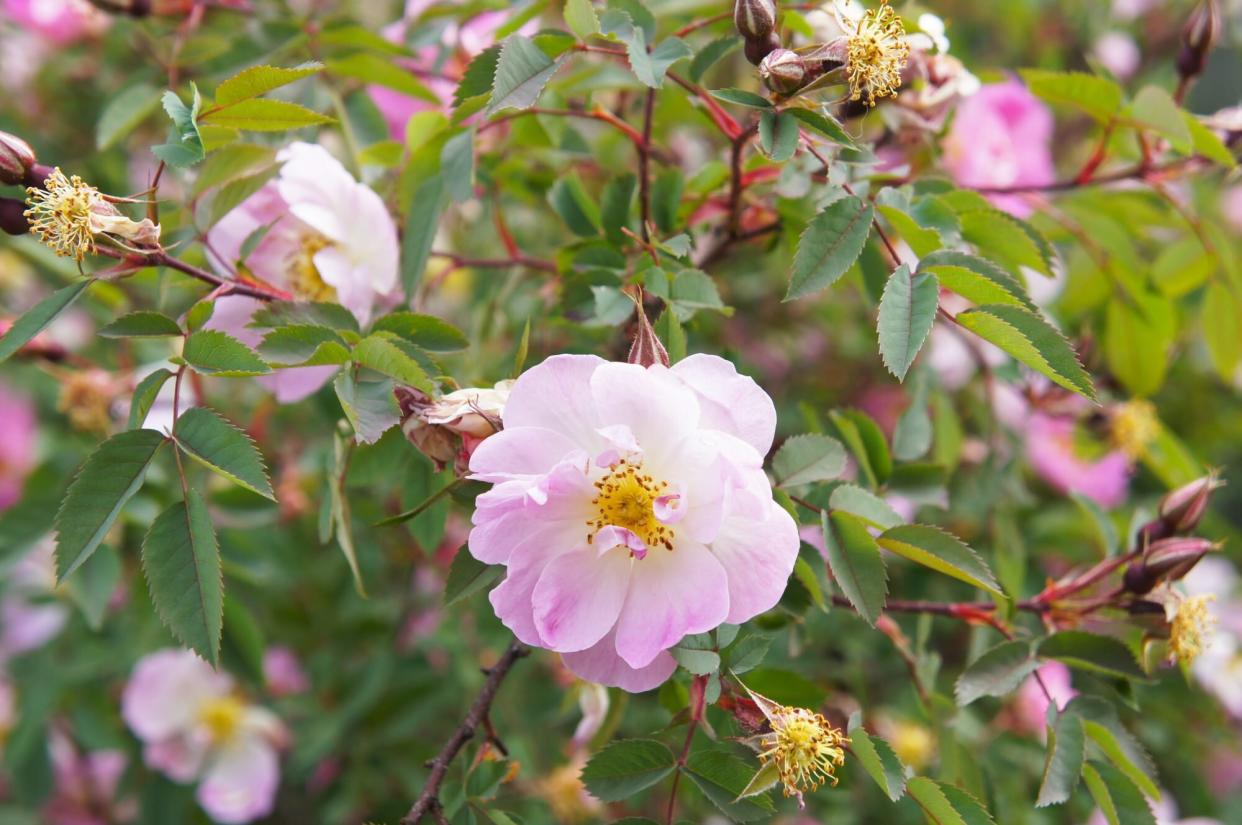How to Grow Roses from Cuttings

Getty Images
TABLE OF CONTENTS
On This Page
What to Know Before You Start
How to Identify Native and Shrub Roses
When to Propagate a Rose by Stem Cuttings
What You'll Need
How To Start a Rose Bush From Cuttings
Sunflowers, herbs, and many other plants are easy to propagate. You can multiply them by sowing seeds, dividing bulbs and tubers, or starting cuttings from the stems or leaves of most herbaceous plants (plants without woody stems). Propagating roses takes a bit more effort because of their woody stems, but it's a great way to add to your garden without breaking your budget.
What to Know Before You Start
Wild roses, known botanically as "species roses," most shrub roses, and native roses are the best choices for this kind of propagation. Hybrid roses are tricky because many are grafted, or developed by fusing the branches from a rose that doesn't perform especially well onto the rootstock of a hardier one. Cuttings started from hybrids will never produce those hardy roots.
However, hybrid cuttings can grow on their own roots. It's a good idea to take multiple cuttings if you try propagating hybrids, since many won't make it. Also, remember that most hybrid roses are patented. You can grow them for yourself, but you can't sell them without the breeder's permission or until the patent expires.
Not sure if a rose has been grafted? Look for a bulge underneath the top growth. In a potted plant, it should be above the soil line.
How to Identify Native and Shrub Roses
Wild roses are wildflowers, plants that grow without human help. All wild roses have single blooms with five petals each, and most are pink.
Native roses also have single, five-petaled blooms. Most are small, rambling shrubs with two to three-foot long canes. Two common natives are the Carolina rose (Rosa Carolina) and the swamp rose (Rosa palustris).
Shrub roses are sprawlers that can grow to 15 feet in all directions. They bear clusters of blooms, and according to the American Rose Society, some are hybrids. Even though shrub rose hybrids grow on their own roots, they can often be successfully propagated from woody stem cuttings.
When to Propagate a Rose by Stem Cuttings
The best time to start roses from cuttings is in the cool fall months. In some climates, that's as early as September or as late as February. Start before all the flowers drop from the bushes, so you can identify each rose and label the cuttings.
Make the cuttings early in the morning or on cool evenings. Carry a bucket of water to keep the cuttings in.
What You'll Need
A sharp, clean knife or pruning shears
One or more mature, healthy rose bushes
Rooting hormone (the powdered form works best)
Small pots
A pencil or dibble
Rose potting mix
Clear plastic bags
Twist ties
Labels
How To Start a Rose Bush From Cuttings
Choose new stems about the diameter of a pencil that have just finished blooming. Make 6 to 8-inch cuttings at a 45-degree angle with a sharp knife or pruners.
Strip off the lower leaves and re-cut the stems just below a node (the spot where a leaf attaches to the stem). Use a knife to make four slices about ¼-inch up from the bottom of the stem. This splits the end of the stem into quarters. (Optional: Dampen the split ends and dip them into a powdered rooting hormone.)
Put the cuttings into small pots filled with rose potting mix. Don't push them in, which will rub off the hormone. Use a pencil or dibble to make a hole and place the sliced end in it. Fill the hole, gently firm down the potting mix, and water thoroughly.
Put the pots in clear plastic bags and insert a few twigs into the mix to keep the bags from touching the cuttings. Close the bags with twist ties, leaving a small gap for ventilation. Check the cuttings often to be sure the mix stays damp. Don't let it get soggy.
Label the cuttings if you haven't already. Keep them near a grow light or bright window that doesn't get direct sun.
After two or three weeks, give the cuttings a slight tug. Once roots have formed, you'll feel some resistance. They're ready to transplant when new leaves appear on the stems and roots have formed.
Transplant the rooted cuttings into 6-inch pots of rose potting mix. Before you move them to a permanent location outdoors, harden them off by exposing them to the elements—sun, rain, and wind—for a longer amount of time each day over a period of 7 to 10 days.
The cuttings may take a few years to bloom. Meanwhile, relax and look forward to your beautiful, new roses.

